Men’s Hair Loss Causes
Overview
Hair loss can affect your scalp or your entire body, and it can be temporary or permanent. It can be the effect of heredity, hormonal changes, medical needs or a normal part of aging. Anyone can lose hair on their head, but it’s more typical in men.
Hair loss in men is mainly caused due to androgenetic alopecia which is also known as “male pattern” or “common” baldness. It occurs due to the effects caused by the male hormone dihydrotestosterone (DHT) on susceptible scalp hair follicles. What DHT does is it causes hair loss by decreasing the growth (anagen) phase of the hair cycle, causing miniaturization (decreased size) of hair follicles which leads to finer and shorter hair day by day until they disappear completely.
Sensitivity to DHT is mostly observed in the hair follicles that are present in the front, top, and crown of the scalp. DHT doesn’t affect the rear and sides of the scalp which makes it pretty easy to identify the pattern. According to the Norwood Classification, this pattern of hair loss primarily begins at the temples and crown area of the scalp. Gradually it may lead to total baldness of the scalp leaving just a few strands of hair near the rear and side areas of the scalp.
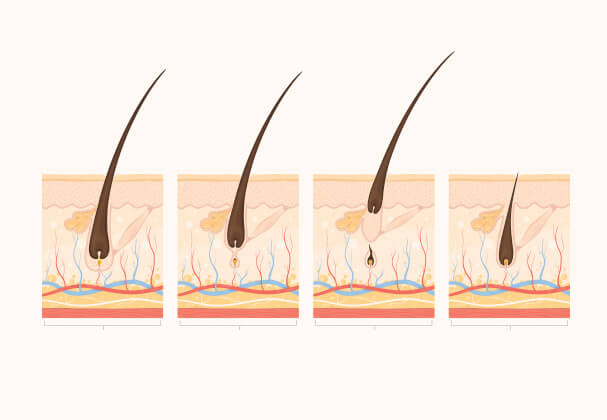
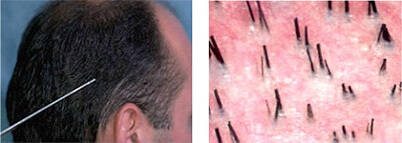
The Miniaturization of Hair Follicles
DHT primarily forms due to the action of 5-alpha reductase on testosterone, the hormone which determines the sex characteristics in men.
DHT has a very adverse effect on the hair of men since it lessens the growth phase of the hair cycle, resulting in miniaturized (shorter size) hair follicles, and thus producing hair that is shorter and thinner in length until this hair disappears.
If we look at the side of this patient’s scalp we observe that these hairs are not affected by DHT. There are groups of hair that are fully thick (called terminal hairs) and there are a few fine, vellus hair present at the spot. The pointer which is visible in the left image indicates the spot from where the close-up view has been acquired. Also, by observing the image above we come to know that the rear and side areas of the scalp haven’t experienced any DHT effects which also makes it an important location for obtaining hair for conducting hair transplants. These hairs are resistant to DHT effects and hence continue to grow in the same fashion as they were in their original position after a successful hair transplant by Dr. Gaurang Krishna has been done.
If we observe the thinning area above (marked by a circle), we can pretty well see that the hair is still present everywhere just that they have miniaturized due to DHT effects gradually over time.
If we observe the circle which is points to the centre of the scalp, we can see that extensive miniaturization has occurred at the spot and there are barely any hairs left. This is due to the action of DHT, which has completely reduced the hairs’ diameter and length so that it appears like the area has gone completely bald.
All these examples given above point to the fact that actual balding takes place at a very later stage and that initially, DHT which leads to miniaturization of hair follicles gives a pseudo effect that a specific area of the scalp has gone completely bald.
Men’s Hair Loss Classification
The Norwood classification, which was issued by the American doctor O’tar Norwood in 1975, is the most famous classification for hair loss in men. It says that there are two primary hair loss patterns in men while there are others that are less common. As per the Norwood pattern, the two areas which are most affected are the temple regions and the crown which gradually enlarge and continue to shed hair until the frontal, top and crown (vertex) of the scalp become bald.
What are the 7 stages of hair loss?
The Norwood scale has seven stages. Each stage measures the severity and pattern of hair loss.
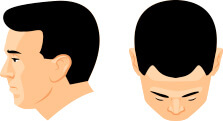
Stage 1
No substantial hair loss or recession of the hairline.
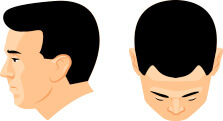
Stage 2
There is a remote recession of the hairline around the temples. This is also understood as an adult or mature hairline.

Stage 3
The first symptoms of clinically significant balding emerge. The hairline becomes extremely recessed at both temples, resembling an M, U, or V shape. The recessed spots are totally bare or sparsely covered in hair.
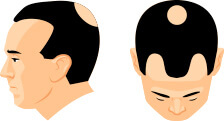
Stage 3 vertex
The hairline remains at stage 2, but there is considerable hair loss on the top of the scalp (the vertex).
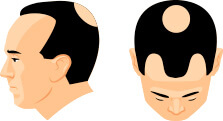
Stage 4
The hairline recession is more extreme than in stage 2, and there is sparse hair or no hair on the vertex. The two areas of hair loss are divided by a band of hair that attaches to the hair remaining on the sides of the scalp.
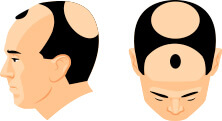
Stage 5
The two areas of hair loss are more extensive than in stage 4. They are still divided, but the band of hair between them is thinner and sparser.
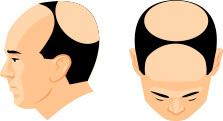
Stage 6
The balding spots at the temples merge with the balding area at the vertex. The band of hair across the top of the head is gone or sparse. The hairs are still present on the sides of the scalp.
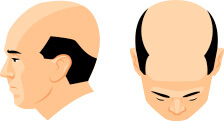
Stage 7
In the most extreme stage of hair loss, only a band of hair going around the sides of the head stays. This hair is usually not thick and may be fine.
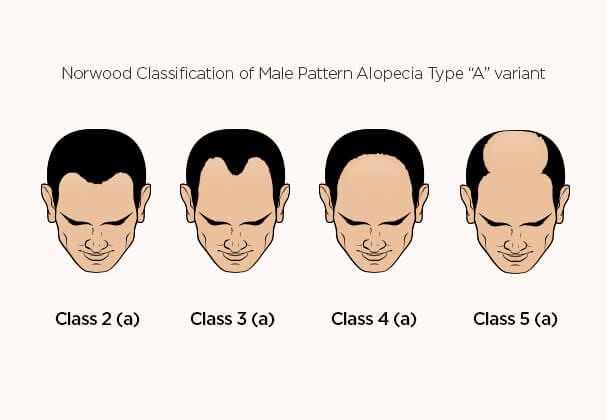
Norwood class A
Diffuse Patterned and Unpatterned Alopecia
Men’s Hair Loss Diagnosis
Classic male pattern baldness is generally diagnosed based on the look and pattern of hair loss. A skin biopsy, blood tests, or other methods may be required to diagnose other disorders that cause hair loss. Before making a diagnosis, our doctors at MedLinks will likely give you a physical exam and ask about your diet, your hair care routine, and your medical and family history. And, then they will suggest the best possible option for you whether it will be a medication course or any hair transplant surgery.
Advantages of Men’s Hair Loss
-
1
Natural Looking Results
-
2
No Additional Scarring With Subsequent Sessions
-
3
Manageable Recovery Time
-
4
Higher Rate Of Follice Survival

Frequently Asked Questions
It is usual to lose about 100 – 150 hair strands each day.
Both men and women can experience androgenetic alopecia, which is triggered by hormones and genetics. Hair loss often happens quickly and more broadly in men. Hair loss in men may personify as early as adolescence with the onset of hair recession near the temples, and the formation of the characteristic “M” shaped hairline. Hair loss in women, on the other hand, ventures diffuse thinning at the top of the head, which shows at the part line. Diffuse thinning can happen as early as their 20s and 30s, due to hormonal changes and aging. In some circumstances, hair thinning and baldness in women may also be caused by treatable illnesses such as thyroid disease or anemia.
This depends on the amount of stress you are experiencing and how much impact it has on the general functions of your body. Normally, the gentle stress we experience on a day-to-day basis does not cause hair loss. However, severe stress that is a result of severe or traumatic events, such as divorce, a drastic change in diet, surgery, or severe weight loss, may cause a physiological imbalance in your system.
Yes, it works! The transplanted hair is removed from the back of the scalp (donor site) and moved to the bald site (recipient site).
The transferred tissue is not “rejected” as it is not foreign tissue. The transplanted hair retains its characteristics; texture, colour, growth rate, and curl, after transplantation and re-growth.
Most patients see results between 6 and 9 months after surgery. For some patients, it takes 12 months.
It’s essential to know that between 2 and 8 weeks after the surgery, the transplanted hair will fall out. This is usual. By the third month, the hair may look thinner than before you had the transplant. Again, this is normal.
- Don’t sleep or lie on your face as it might cause swelling. Sleep with your head elevated to 30 degrees, at least for 3 days.
- Don’t consume alcohol or alcoholic beverages for at least 3 days after the surgery.
- Avoid visiting dirty or dusty environments for at least a week after the procedure.
- Shampoo very gently for the first week after the procedure. Since grafts are permanent, one can resume normal hair care and shampoo after 10 days.
- Restrain yourself from smoking for at least 2 weeks after the surgery.
- Avoid consuming any kind of medications that affect blood flow.
- Don’t have a haircut for at least 3 weeks after the surgery.
- Don’t colour or dye your hair for at least 4 weeks after the surgery.
Looking for guidance?
Book a consultation today and clear all your doubts with MedLinks!

Looking for guidance?
Book a consultation today and clear all your doubts with MedLinks!

